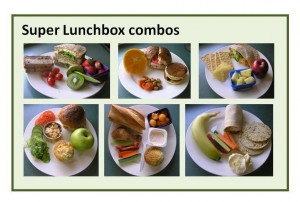Healthy Lunchboxes Key to Focus and Learning in Classroom
The humble lunchbox and its contents have certainly had plenty of media attention this year. If you are feeling overwhelmed with all this info, we’ve simplified it for you. Regular and healthy meals and snacks including both carbohydrate and protein improve memory and learning. A healthy lunchbox can help children and adolescents stay focussed and concentrate in the classroom, helping learning performance and behaviour.
Here are our top tips for a healthy lunchbox:
Tip 1: Balance
Include something from each of the 5 food groups:
- Bread, rolls, wraps, pita, fruit loaf, corn or rice cakes, crisp bread, pikelets, cereal, rice, pasta, noodles, quinoa
- Vegetables and salad – fresh, cooked or canned
- Fruit – fresh, frozen, tinned in natural juice
- Dairy – cheese, milk, yoghurt or custard
- Meat or meat alternative – chicken, ham, roast meat, boiled egg, canned fish, baked beans
Once you something from all these groups, the combinations are endless. See here for some great options:
Super Lunchbox Combos
Tip 2: Keep it Cool & Safe
As you know, food safety is a serious issue, this is especially the case when talking about lunchboxes. Here are some ideas to keep your child’s lunch cool and safe.
- Make sure the food and drink are cold before packing them into the lunchbox. You can do this by using frozen bread slices or rolls (cut in half before freezing) to make sandwiches or make the sandwiches/rolls the night before and freeze.
- A cold/frozen drink bottle is a great idea but remember once your child has finished the drink it will no longer keep the food cold. Use an ice brick as well.
- Keep food and drinks in the fridge until your child leaves for school.
- Once home from school throw out any perishable food or drinks not consumed.
- Clean the lunch box and containers in warm soapy water after each use.
Tip 3: Keep it Interesting
Kids are more likely to eat their lunch if they have a say about what goes in:
- Go shopping together and let them choose the fruit
- Get kids involved in making food for their lunch, eg. fruit or savoury muffins, pikelets, mini pizzas or savoury rice. These can be made over the weekend and frozen for use during the week ahead.
Make sandwiches more exciting by cutting them into different shapes – cookie cutters work well for this
Use various types of bread, such as, rolls, wraps or pita bread as an interesting alternative to a sandwich
Together with your child, make a list of ‘favourite lunches for the week’ – this helps ensure food variety, which is good for health, and will keep your child interested in lunch
Occasionally add a surprise to your child’s lunchbox such as coloured serviettes, notes, stickers or a flower
If you find your child is starting to bring back home more and more food in their lunchbox each day, it is time to try something new
Want more tips and ideas – see our lunch box fact sheets
Ideas for Sandwich Fillings
Lunchbox – Food Safety
Healthy Snacks for Children
Lunchbox menu planning
A note for teachers:
Nutrition Australia Qld does not support the practice of “lunchbox inspections”. School lunches packed by parents can reflect:
- Personal choice & family income
- Parental knowledge about health and nutrition
- Cultural differences
If children’s lunchboxes are used as part of a lesson, its important that students do not feel judged or or criticised because of its contents – rather aim only to facilitate discussion.



